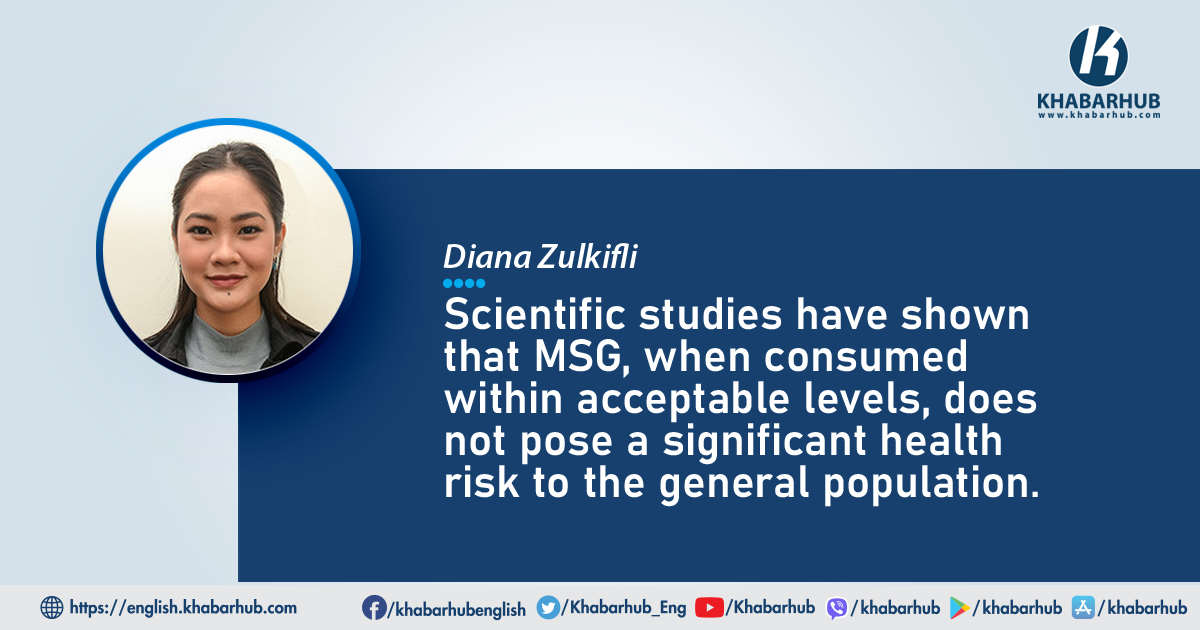Monosodium Glutamate (MSG) is often linked to Asian cuisine, especially Chinese food, due to historical perceptions.
However, this almost odorless, salt-like additive is widely used across the global food industry.
As the demand for fast and convenient food rises, the MSG market continues to grow despite ongoing debates about its health effects.
According to a BCC Research report, the global MSG market – valued at $6.6 billion in 2022 – is expected to grow at a compound annual growth rate (CAGR) of 6.1%, reaching $9.2 billion by 2028 (Publishing, 2023).
Although many people identify as MSG-sensitive, scientists have not been able to consistently trigger reactions in studies with such individuals given MSG or a placebo. The FDA considers the addition of MSG to foods to be “generally recognized as safe” (GRAS) (Program, 2018).
Still, the name “Monosodium Glutamate” sounds chemical-like, and chemicals are usually bad – aren’t they? To answer this, we need to go back in time.
1908: The Discovery of MSG
In 1908, Japanese chemist Dr. Kikunae Ikeda extracted glutamate from kelp broth and identified it as the key compound responsible for a distinct savory flavor. He named this taste “Umami,” which translated to “pleasant savory taste.”
Some theories suggest that because MSG enhances flavor, it could lead to overeating. However, this effect is not unique to MSG – any seasoning that makes food more appetizing could contribute to increased consumption.
Dr. Ikeda discovered a way to replicate this flavor-enhancing reaction by isolating high concentrations of glutamate and combining it with sodium to create a seasoning that could instantly boost umami in any dish.
According to the FDA, today, MSG is produced through the fermentation of starch, sugar beets, sugarcane, or molasses, a process similar to those used to make yogurt, vinegar, and wine (Program, 2018).
Umami is now recognized as one of the five basic tastes in food science, alongside sweet, sour, salty, and bitter. Each basic taste is produced by unique molecular mechanisms that cannot be replicated by combining other known tastes.
In the case of umami, those mechanisms arise when we slow-cook for hours or ferment certain foods for a long period, breaking down their proteins and releasing amino acids like glutamate.
Dr. Ikeda’s discovery was groundbreaking, and by the mid-20th century, MSG became a staple ingredient in commercial food production worldwide.
1968: The Fear Around MSG and “Chinese Restaurant Syndrome”
Concerns over MSG emerged in 1968 after Dr. Ho Man Kwok wrote a letter to the editor of The New England Journal of Medicine. He described experiencing symptoms such as headache, flushing, and a feverish sensation after eating at a Chinese restaurant.
Although Dr. Kwok speculated that other dietary factors – like sodium or alcohol – could have been responsible, the letter drew attention to MSG as the primary suspect.
His intention was merely to raise discussion, but instead, his letter led to widespread fear and misinformation, ultimately turning MSG into a widely misunderstood and controversial ingredient.
At the time Dr. Kwok’s letter was published, scientists had already identified glutamate as a key neurotransmitter crucial for brain function (Purves et al., 2001).
His letter sparked immediate concern, prompting calls for scientific investigations into the safety of MSG.
On one hand, this reaction was understandable, as the additive had not been tested for toxicity, and its health effects were largely unknown.
However, it’s likely many people were not responding to a lack of food safety regulation per se, but rather the letter’s title: “Chinese Restaurant Syndrome.”
Despite MSG being widely used in various cuisines, history has shown a persistent bias against Asian food practices, often labeling them as unusual, exotic, or even hazardous.
The bias fueled racially charged media coverage, leading to widespread fear that consuming Chinese food could cause illness. Sensationalized reports exaggerated concerns about MSG and umami, even when scientific studies produced inconclusive findings.
At present, Merriam-Webster has updated its definition of “Chinese Restaurant Syndrome.”
Once considered a legitimate illness linked to Chinese cuisine, the term is now marked as “outdated” and “offensive.”
The dictionary also clarifies that research since the term was coined in 1960 has found no conclusive evidence linking MSG to the reported symptoms.
Additionally, it now directs readers to a more neutral scientific term: MSG Symptom Complex.
What is Monosodium Glutamate (MSG)?
MSG is composed of two common substances: sodium, an essential dietary component, and glutamate, an amino acid that serves as a building block of proteins.
Glutamate is naturally present in various plant and animal proteins and is also found in fermented foods such as aged cheeses, tomatoes, mushrooms, and more.
While some argue that the natural occurrence of glutamate in food makes MSG harmless, it is important to recognize the difference between foods that contain up to 1% of natural glutamate and a pure hit of the concentrated, industrially processed form.
Though, New South Wales Food Authority indicates that the body metabolizes MSG in the same way as naturally occurring glutamate from whole foods.
In other words, the body does not distinguish between free glutamate from sources like tomatoes, cheese, or mushrooms and the glutamate derived from MSG (NSW Food Authority, 2024).
The Federation of American Societies for Experimental Biology (FASEB), the Joint Food and Agriculture Organization/World Health Organization Expert Committee on Food Additives (JECFA), and Food Standards Australia New Zealand (FSANZ) have all reviewed the safety of MSG and found that it poses no health risks to the general public (MSG in Food | Food Standards Australia New Zealand, 2017).
MSG Symptom Complex
Like with many food ingredients, a small percentage of people may experience mild, short-term reactions to MSG.
A Harvard Health Publishing review notes that while most individuals can consume MSG without any problems, fewer than 1% of the general population may be particularly sensitive to it.
Symptoms, which typically appear within two hours of consumption, may include headaches, skin flushing, sweating, nausea, numbness, and fatigue.
In extremely rare cases, some individuals may experience severe allergic reactions (Warner, 2024). Those who are sensitive to glutamate should limit their intake of MSG, whether added in food as an additive or naturally occurring.
Potential Health Concerns Linked to MSG
Although the U.S. Food and Drug Administration (FDA) considers MSG generally safe, it has been associated with several negative health effects. One of the most commonly discussed concerns is its potential to trigger headaches and migraines.
According to the American Migraine Foundation, MSG is arguably the most well-known food additive that has been linked to migraine attacks; it has been shown to cause rapid cramping, diarrhea, and migraine attacks in 10% to 15% of migraineurs.
It is important to note that no scientific studies have examined the effects of MSG on migraineurs (American Migraine Foundation, 2025).
Since glutamate acts as a neurotransmitter in the brain, some theorize that a compound with excitatory effects on nerve cells could be problematic for individuals prone to migraines. However, scientific evidence linking MSG to migraines is mixed.
A multicenter, multiphase, double-blind, placebo-controlled study with a crossover design was conducted to evaluate reactions reportedly caused by MSG.
In protocols where MSG was administered without food, some participants experienced more reactions with MSG than with placebo. But, when MSG was given with food, there was no significant difference in reactions between MSG and placebo.
The study concluded that reactions to MSG are inconsistent and may require specific conditions to manifest (Geha et al., 2000).
A more recent review published in Current Pain and Headache Reports analyzed multiple clinical trials conducted over the past few decades.
The findings of MSG’s role in triggering headaches remain inconclusive, as results have been inconsistent.
Additionally, many of the studies used MSG doses far higher than what people typically consume in their diets (Ahdoot & Cohen, 2023).
Another concern surrounding MSG is its potential link to obesity. In 2008, a study was conducted to investigate the link between MSG intake and overweight in Chinese adults.
Researchers analyzed dietary habits of 752 participants and found that higher MSG consumption was associated with an increased risk of being overweight, independent of total energy intake and physical activity.
The findings of this study suggest a possible role of MSG in weight gain, potentially due to its effects on metabolism and appetite regulation. However, causation is not established (He et al., 2008).
One study was carried out in 2014, to review the potential relationship between dietary MSG and obesity. The study found that while some epidemiological and animal studies suggest a link, controlled intervention studies in humans and animals do not support this.
The authors of the study concluded that environmental factors, not MSG itself, likely explain weight gain trends. Additionally, dietary MSG does not enter the bloodstream or brain in significant amounts.
It is widely available in local markets and online, with several suppliers offering high-quality MSG products. One notable supplier in Nepal is Tag Ingredients India Pvt. Ltd., which provides MSG for culinary use.
Therefore, normal MSG consumption is unlikely to impact body weight or fat metabolism (Brosnan et al., 2014). There is no definitive conclusion on whether MSG directly contributes to weight gain. It is essential to consider that MSG-containing foods are often part of broader dietary patterns that can influence weight, rather than MSG itself being the main cause.
Some theories suggest that because MSG enhances flavor, it could lead to overeating. However, this effect is not unique to MSG – any seasoning that makes food more appetizing could contribute to increased consumption.
If a person eats a lot of highly processed food with MSG, weight gain is more likely to occur due to overall diet quality.
MSG consumption has also been linked to a higher risk of metabolic disorders such as insulin resistance, high blood sugar, and diabetes.
A study in 2018 discusses the potential health risks associated with extensive MSG consumption, linking it to metabolic disorders, obesity, neurotoxicity, and liver damage.
It highlights MSG’s effects on glutamate receptors, which regulate metabolism and neuronal activity. While animal studies show links to insulin resistance and inflammation, human data remain inconclusive.
Overall, the study calls for more research and regulatory attention on the matter (Niaz et al., 2018).
Much of these claims are primarily based on animal studies that have used methods such as injecting dosages of MSG rather than administering it orally.
This approach does not accurately reflect how humans consume MSG, making it difficult to draw clear conclusions about its effects on metabolism and overall health.
A study review conducted in 2019 set out to survey the available literature on preclinical studies and clinical trials regarding the alleged adverse effects of MSG. It aims to provide a comprehensive overview of the reported possible risks that may arise following chronic exposure.
The study was also intended to critically evaluate the relevance of the data for dietary human intake. The review paper posits that many reported negative effects of MSG are likely to have little relevance at the low doses people typically consume.
As with any ingredient, moderation is key, and consumers who experience sensitivity should avoid excessive amounts. Despite the backlash it faced decades ago, MSG continues to play an important role in the food industry due to its unique flavor-enhancing properties, even in Nepal.
To be meaningful to human health, laboratory studies must use realistic species, dosages, and methods of intake.
Clinical studies should also account for both added and naturally occurring MSG to ensure accurate results (Zanfirescu et al., 2019).
MSG in Nepal
In Nepal, MSG is commonly found in foods like instant noodles, chowmein, and momo.
It is widely available in local markets and online, with several suppliers offering high-quality MSG products. One notable supplier in Nepal is Tag Ingredients India Pvt. Ltd., which provides MSG for culinary use.
Public perception of MSG in Nepal is mixed, much like in other parts of the world. The country’s food regulations require manufacturers to list MSG on product labels, ensuring transparency similar to the requirements in India.
The majority of snack foods in the region still contain MSG due to its flavor-enhancing properties and the growing demand for processed food. However, health-conscious individuals in Nepal may avoid MSG in favor of natural flavoring agents like herbs and spices.
Additionally, some international food chains and local restaurants in Nepal advertise MSG-free options to cater to consumers who prefer avoiding the additive.
In conclusion, while the safety of MSG remains a controversial subject for some, much of the concern appears to be based on misinformation or a misunderstanding of its effects.
Scientific studies have shown that MSG, when consumed within acceptable levels, does not pose a significant health risk to the general population.
As with any ingredient, moderation is key, and consumers who experience sensitivity should avoid excessive amounts. Despite the backlash it faced decades ago, MSG continues to play an important role in the food industry due to its unique flavor-enhancing properties, even in Nepal.









Comment